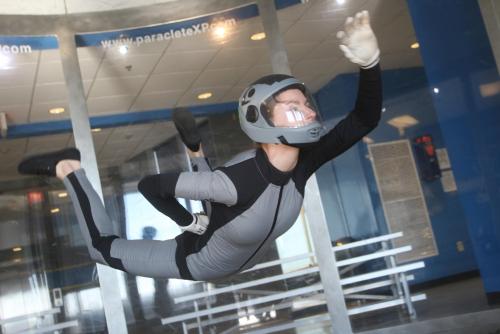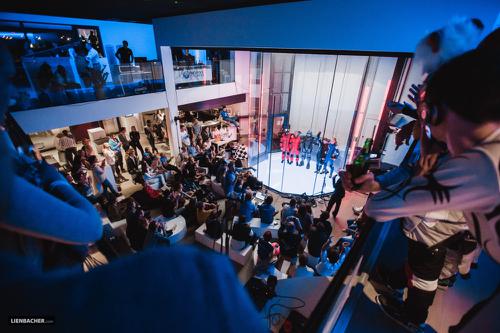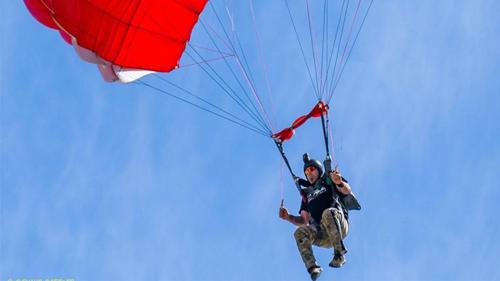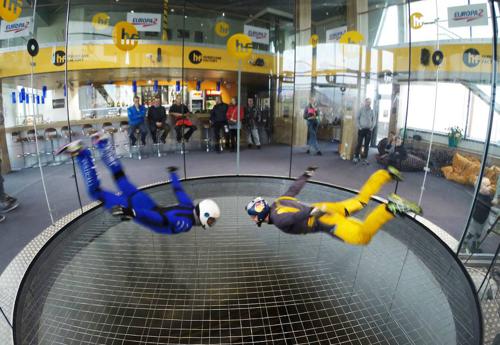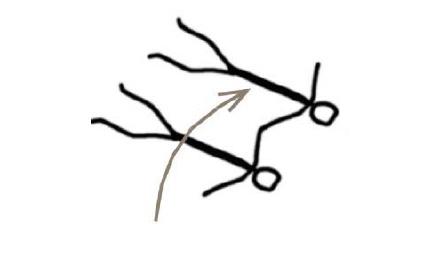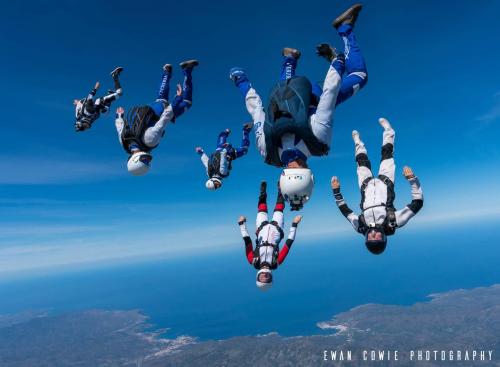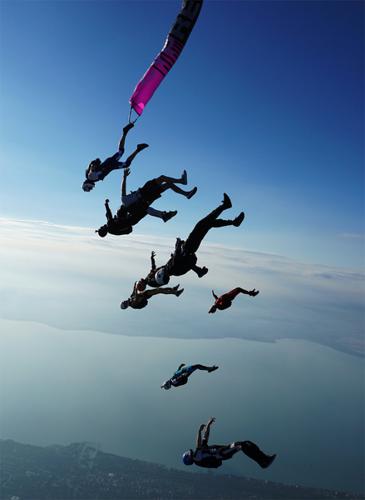1. AUTHORITY
The competition will be conducted under the authority granted by the Atmonauti
Committee of the Sports Skydivers Association. All participants accept these rules and
regulations as binding by registering as a competitor for the competition.
2. DEFINITIONS
2.1 Atmonauti Body Position
Atmonauti is the term given to the technique that intentionally utilises the torso (as
an aerofoil) to generate lift, while ‘diving’ at an angle of between 30deg – 75deg to
generate relative wind required for lift.
Use of the torso to achieve lift allows freedom of limbs to achieve a range of
handgrips and foot docks, essential for the ARW2 and SFIDA competition formats.
2.2 Atmonauti Relative Work
2.2.1 Sequences and Blocks, including transitions and inters, to include
Frontmonauti, Backmonauti and Footmonauti positions.
2.2.1.1 Frontmonauti: Head first into relative wind, torso to earth
2.2.1.2 Backmonauti: Head first into relative wind, back to earth
2.2.1.3 Footmonauti: Feet first into relative wind, back to earth
2.3 SFIDA “Challenge”
Neutral Navigator sets direction, angle and speed, Competitors compete side by
side of the Navigator and aim to score highest points for that jump by virtue of
preset docks and grips, to include transitions.
2.4 Team
An Atmonauti Relative Work Team will consist of two (2) competitors and a
videographer. For SFIDA no team will exist and two (2) competitors will compete
against each other navigated by an appointed qualified navigator. The
Videographer will be independent from the competitors.
Grip and docks
2.4.1 Grip: a recognisable stationary contact of the hand or hands of one
competitor on a specified part of the body or harness of the other
competitor, executed in a controlled manner.
2.4.2 Dock: A recognisable stationary contact of the foot or feet of the one
competitor on a specified part of the body or harness of the other
competitor, executed in a controlled manner.
2.5 Heading
The direction in which the “leading edge” of the performer faces. further defined in
terms of Backmonauti and Frontmonauti positions
2.6 Leading edge
A specific body part of the performer (either head or feet) which is the first point of
contact with the relative wind generated from the angle of attack
2.6.1 Frontmonauti: Head first into relative wind, torso to earth
2.6.2 Backmonauti: Head first into relative wind, back to earth
2.6.3 Footmonauti: Feet first into relative wind, back to earth
2.7 Axis
2.7.1 3 axis – F (flight direction), P (Perpendicular to F) & H (Horizontal)
2.8 Atmonauti position
Objective is to achieve head-on relative wind (or a custom “tube”) at an angle of
between 30deg – 75deg to the ground, with horizontal movement in relation to the
ground, whilst searching for lift with the torso - freeing up the limbs to achieve hand
grips and foot docks.
2.9 Move
A change in body position, and/or a rotation around one or more of the three body
axes or a static pose.
2.10 Navigator
Neutral Navigator responsible for setting direction, angle and speed. No eye contact
or assistance should be present.
2.11 No Fly Zone Frontmonauti<.p>
Behind, below, and not on head level during the approach (i.e. must be above,
ahead and on head level).
2.12 No Fly Zone Backmonauti
Ahead, above, and not on head level during the approach (i.e. must be below,
behind and on head level).
2.13 Head level
The level of the approaches - utilising the head as reference in relation to the angle
of attack set by Navigator.
2.14 Total Separation
Is when all competitors show at one point in time that they have released all their
grips and no part of their arms or body have contact with another body.
2.15 Inter
Is an intermediate requirement within a block sequence which must be performed
as depicted in the dive pool.
2.16 Sequence
Is a series of random formations/free moves and block sequences which are
designated to be performed on a specific jump.
2.17 Scoring move/formation
Is a move which is correctly completed and clearly presented either as a free move
or within a block sequence as depicted in the dive pool, and which, apart from the
first move after exit, must be preceded by a correctly completed and clearly
presented total separation or inter, as appropriate
2.18 Infringement
2.18.1 An incorrect or incomplete formation which is followed within working time
by either
2.18.1.1 Total separation or,
2.18.1.2 An inter, whether correct or not.
2.18.2 A correctly completed formation preceded by an incorrect inter or incorrect
total separation
2.18.3 A formation, inter, or total separation not clearly presented
2.18.4 In SFIDA, where one or both competitors cause instability to the navigator,
adversely affecting the other competitor on the same jump.
2.19 Omission
2.19.1 A formation or inter missing from the draw sequence
2.19.2 No clear intent to build the correct formation or inter is seen and another
formation or inter is presented and there is an advantage to the team
resulting from the substitution.
2.20 Working Time
Is the period of time during which teams are scored on a jump which starts the first
moment and competitor (other than the videographer) separates from the aircraft,
as determined by the Judges and terminates a number of seconds later as specified
in chapter 3.
2.21 NV
Moves, inters, or total separations not visible on screen due to meteorological
conditions, or factors relating to the videographer's freefall video equipment that
cannot be controlled.
2.22 Rounds
Minimum 1 round to call the meet.
2.23 Backmonauti
The performer will be on heading flying on his back with his back towards the earth.
2.24 Frontmonauti
The performer will be on heading flying at the defined angle as per atmonauti
definition with his back towards the sky.
2.25 Footmonauti
The performer will be on heading feet-first flying at the defined angle as per
atmonauti definition with his back towards the ground.
2.26 Formation
A record attempt formation is considered as built when two or more competitors fly
on heading with a predefined dock or grip held for minimum 3 seconds, and is the
basis for the Atmonauti Linked National/World Records. A free move formation,
however, is merely a recognisable stationary contact of the hand/hands or foot/feet
– and does not require to be held for 3 seconds as per record attempts.
3. ROUTINES
3.1 The discipline is comprised of SFIDA and Atmonauti Relative Work.
3.2 Number of rounds:
a. SFIDA: a total of 4 competition rounds will be completed with a minimum of one
round to be completed before a meet can be called.
b. ARW: a total of 5 competition rounds will be completed with a minimum of one
round to be completed before a meet can be called.
3.3 All SFIDA competitions will be judged by an elimination process where the two
highest scoring competitors in any given round will compete against each other in the following round and the second and third ranking competitors will compete
against each other and so forth.
3.4 In the case of a tie for a specific round, the previous total points are added to
identify the highest total average per competitor.
3.5 Should a tie persist, a one jump tie breaker will be performed with the highest
scoring competitor moving to the next round.
3.6 A tie breaker may also be required for placing 1st, 2nd, 3rd.
4. THE EVENTS
4.1 The discipline will be comprised of the following events:
4.1.1 ARW Events: Exit altitude is 11 000 feet AGL; working time is 40 seconds.
4.1.2 SFIDA Events: Exit altitude is 11 000 feet AGL; working time is 40
seconds.
4.1.3 For meteorological reasons only, and with the consent of both the Event and Chief Judge, the Meet Director might change the exit altitude and/or working time and continue the competition. In this case the following
conditions will apply:
4.1.3.1 The working time will be:
a. 20 or 40 seconds for the ARW Events
b. 20 or 40 seconds for the SFIDA Events.
The reduced working time must be used if the exit altitude is lowered (ref 4.1.1 and 4.1.2). The next round must commence if working time is changed and all competitors will be scored on
the same working time for a specific round.
4.1.3.2 The minimum exit altitude will be:
a. 7 000 feet AGL for the ARW Events
b. 7 000 feet AGL for the SFIDA Events.
The maximum exit altitude will be 13 000 feet AGL for all
events.
4.2 Objective of the Event
4.2.1 The objective of the event is for the a team (ARW) or single competitor
(SFIDA) to complete as many scoring moves as possible within the given
working time, while correctly following the sequence for the specific round.
4.2.2 The accumulated total of all rounds completed is used to determine the
placing of teams for ARW and the process of elimination as defined in chapter 3 is applied to determine the placing of individual SFIDA
competitors.
4.2.2.1 For ARW if two or more teams have equal scores the following order of procedures will be applied:
4.2.2.1.1 For determining final standings:
a. the highest score in any completed round;
b. the highest score starting with the last completed
round and continuing in reverse order, round by
round until the tie is broken,
c. the fastest time (measured to hundredths of a
second) to the last common scoring move in the
last completed round.
d. one tie break round if possible (for the first three
placings only).
4.3 Performance Requirements
4.3.1 Each round consists of a sequence of formations depicted in the dive pools
of the appropriate annexes, as determined by the draw.
4.3.2 It is the responsibility of the team or individual competitor to clearly present
the start of working time, correct scoring moves, inters and total separation to the judges.
4.3.3 Scoring moves need not to be perfectly symmetrical, but they must be
performed in a controlled manner. Mirror images of moves and whole
block sequences are not permitted.
4.3.4 In sequences, total separation is required between block sequences,
between free or random moves, and between block sequences and free
moves.
4.3.5 Where degrees are shown (180, 270, 360, 540) this indicates the approximate degrees and direction of turn required to complete the inter as intended. The degrees shown are approximately that amount of the circumference of the subgroup's centre point to be presented to the centre point(s) of the other subgroup(s). For judging purposes, the approximate degrees and direction of turn of subgroups centrepoints will be assessed using only the two dimensional video evidence as presented.
4.3.6 Contact or grips are allowed between subgroups during execution of the
inter.
4.3.7 Where subgroups are shown, they must remain intact as a subgroup with
only the depicted grips.
4.3.8 Assisting handholds on other jumpers or their equipment within a
subgroup/competitor or a scoring formation are permitted.
5. GENERAL RULES
5.1 Teams may consist of competitors of either or both sexes, except in the female
event where (except for the videographer) all competitors must be female.
5.2 The Draw
5.2.1 The draw of the sequences will be supervised by the Chief Judge. Teams
will be given not less than two hours knowledge of the results of the draw
before the competition starts.
5.2.2 Event Draws: All the «Block sequences» (numerically numbered) and the
«Free moves» (alphabetically marked) shown in the appropriate annex will be singularly placed in one container. Individual withdrawal from the
container, (without replacement) will determine the sequences to be jumped in each round. Each round will be drawn so as to consist of three
or four scoring formations, whichever number is reached first. Alternatively this draw can be done on a Recognised electronic scoring/judging system as approved by the Meet Director and Chief Judge.
5.2.3 Use of Dive Pool: Each block or formation will be drawn only once for the scheduled rounds of each competition. In the event that additional rounds are necessary, due to the tie-breaking jump-off, the dive pool for this round will consist of the blocks and free moves which were not drawn for the scheduled rounds. In the event that all of the remaining blocks and formations do not complete the tie breaking round, the draw will continue from an entire original dive pool in that event, excluding any blocks or formations which have already been drawn for that round.
5.3 Competitors are not allowed to use a wind tunnel (freefall simulator) after the draw
has been made.
5.4 Jump Order
5.4.1 Determined by a draw.
5.4.2 Should conditions or availability not allow for Jump Order to be executed
as per draw, Competitors ready and present shall be given first option to
continue with the rounds.
5.5 Video Transmission and Recording
5.5.1 Each team shall provide the video evidence required to judge each round.
Each freefall Videographer must use the video transmission system if
provided by the Organiser.
5.5.2 For the purpose of these rules, «freefall video equipment» shall consist of the complete video system(s) used to record the video evidence of the team’s freefall performance, including the camera(s), video media, tape recorder(s), and battery(ies). All freefall video equipment must be able to deliver a PAL digital signal through an IEEE 1395 compatible connection (Firewire) or composite video compatible connection.
5.5.3 As soon as possible after each jump is completed, the freefall videographer must deliver the freefall video equipment (including the tape(s) used to record that jump) for dubbing at the designated dubbing station.
5.5.4 Only one video recording will be dubbed and judged. Secondary video recordings may only be used in NV situations.
5.5.5 The dubbing station will be as close to the landing area as possible.
5.5.6 A Video Controller will be appointed by the Chief Judge prior to the start of the Judges’ Conference. The Video Controller may inspect a team’s freefall video equipment to verify that it meets the performance requirements as determined by him/her. Inspections may be made at any time during the competition which do not interfere with a team’s performance, as determined by the Event Judge. If any freefall video equipment does not meet the performance requirements as determined by the Video Controller, this equipment will be deemed to be unusable for the competition.
5.5.7 A Video Review Panel will be established prior to the start of the official training jumps, consisting of the Chief Judge, the President of the Jury, and the Chairman, or acting Chairman, of the Atmonauti SSA Committee.
Decisions rendered by the Video Review Panel shall be final and shall not be subject to protest or review by the Jury.
5.5.8 If the Video Review Panel determines that the freefall video equipment has been deliberately tampered with, the team will receive no points for all competition rounds involved with this tampering.
5.6 Exit Procedure
5.6.1 Exit first (prior to FS, AE, Wingsuiting on the same jump run) at altitude.
There are no limitations on the exit other than those imposed by the JM for
safety reasons.
5.6.2 The exit will be controlled by the Navigator in SFIDA and Team Principle in ARW2. Exit commands will be made using an appropriate signal system, and should be discussed prior to boarding with the pilot.
5.6.3 Atmo groups will be required to fly minimum 45 degrees off jump run in order to create horizontal separation to freefall groups exiting after atmonauti group.
5.7 Scoring
5.7.1 A team will score one point for each scoring move performed in the sequence within the allotted Working Time of each round. Teams may continue scoring by continually repeating the sequence.
5.7.2 For each omission two points will be deducted. If both the inter and the second move in a block sequence are omitted, this will be considered as only one omission.
5.7.3 If an infringement in the scoring move of a block sequence is carried into the inter (ref. 2.8), this will be considered as one infringement only, provided that the intent of the inter requirements for the next formation is clearly presented and no other infringement occurs in the inter.
5.7.4 The minimum score for any round is zero points, except where zero points have been awarded and penalty/ies imposed.
5.8 Rejumps
5.8.1 In a NV situation, the video evidence will be considered insufficient for judging purposes, and the Video Review Panel will assess the conditions and circumstances surrounding that occurrence. In this case a rejump will be given unless the Video Review Panel determines that there has been an intentional abuse of the rules by the team, in which case no rejump will
be granted and the team’s score for that jump will be zero.
5.8.2 Contact or other means of interference between competitors in a team and/or their Videographer shall not be grounds for the team to request a rejump with regards to ARW. In the case of the SFIDA category adverse whether conditions such as bad visibility (in cloud), any contact or other means of interference between the navigator and competitiors and/or between the Videographer shall be grounds for the individual competitors
to request a rejump – granted at the sole discretion of the Atmonauti Event Judge.
5.8.3 Adverse weather conditions during a jump are no grounds for protest. However, a rejump may be granted due to adverse weather conditions, at
the discretion of the Chief Judge.
5.8.4 Problems with a competitor’s equipment (excluding freefall video
equipment) shall not be grounds for the team to request a rejump.
5.9 Training Jumps
5.9.1 Each team in each event will be given the option of one official training jump before the draw is made.
5.9.2 The aircraft type and configuration, plus the judging and scoring systems to
be used in the competition will be used for the official training jump.
5.9.3 Two sequences will be created by the Chief Judge. Only teams performing
one of these sequences will receive an evaluation and posted score.
6. JUDGING
6.1 The official training jump and competition jumps will be judged as the Videographer
provides the video evidence. The Chief Judge may modify this procedure with the
consent of the FAI Controller.
6.2 The judging will, as far as practical circumstances allow (landings out, rejumps etc),
be judged in the reverse order of placing.
6.3 Three Judges must evaluate each team’s performance.
6.4 The Judges will watch the video evidence of each jump to a maximum of three times at normal speed. If, after the viewings are completed, and within fifteen seconds of the knowledge of the result, the Chief Judge, Event Judge or any Judge on the panel considers that an absolutely incorrect assessment has occurred, the Chief Judge or Event Judge will direct that only that part(s) of the jump in question be reviewed. If the review results in a unanimous decision by the Judges on the part(s) of the performance in question, the score for the jump will be adjusted accordingly. Only one review is permitted for each jump.
6.5 The Judges will use the electronic scoring system to record their evaluation of the performance. At the end of working time, freeze frame will be applied on each viewing, based on the timing taken from the first viewing only. The Judges may correct their evaluation record after the jump has been judged. Corrections to the
evaluation record can only be made before the Chief Judge signs the score sheet. All individual Judge’s evaluation will be published.
6.6 A majority of Judges must agree in the evaluation in order to;
• credit the scoring move, or
• assign an omission, or
• determine an NV situation.
6.7 The chronometer will be operated by the Judges or by a person(s) appointed by the
Chief Judge, and will be started as determined in 2.13. If Judges cannot determine
the start of the working time, the following procedure will be followed. Working time
will start as the videographer separates from the aircraft and a penalty equal to 20%
(rounded down) of the score for that jump will be deducted from the score for that
jump.
7. RULES SPECIFIC TO THE COMPETITION
7.1 Title of the Competition: Atmonauti National/World/Continental Championships
7.2 Aims of Atmonauti National/World/Continental Championships
7.2.1 To determine National/World/Continental Champions of Atmonauti in the:
• ARW (Atmo Relative Work),
• SFIDA “Challenge”
7.2.2 and
• To determine the world standings of the competing teams,
• To establish Atmonauti formation/distance/other world records,
• To promote and develop Atmonauti,
• To present a visually attractive image of the competition jumps and
standings (scores) for competitors, spectators and media,
• To exchange ideas, experience, knowledge and information, and
strengthen friendly relations between the sport parachutists, judges, and
support personnel of all nations,
• To improve judging methods and practices.
7.3 Composition of Delegations:
7.3.1 Each delegation may be comprised of:
• One (1) Head of Delegation,
• One (1) Team Manager,
• Freefall videographers as.7.3.4 and
7.3.2 At a World/Continental Championship:
• Two (2) ARW2 teams consisting of up to:
Six (6) ARW2 Competitors
• One (1) female ARW2 team consisting of up to:
Three (3) female ARW2 Competitors
• SFIDA contestants consisting of up to:
Three (3) Individual Competitors
7.3.3 At a World Cup:
• Any number of teams per event (composed as for a World
Championship) to be decided by the Organiser and announced in the
bulletins.
7.3.4 Videographers must be entered for each team as part of the delegation and must be a member of the Delegation’s NAC. A Videographer may be replaced at any time during the competition, (with the agreement of the FAI Controller). The evaluation process for the video evidence will be the same for any Videographer. Videographers may be one of the following:
a. One person in addition to the team composition in 7.3.2. This competitor
is to be considered as a team member for the purposes of awards and
medals.
b. Any other person (ref 7.3.6). This Videographer is eligible to receive
awards and medals. This Videographer may jump as a ‘pool’ Videographer and is subject to the same regulations as other competitors on the team.
7.3.5 If any ARW team consists of competitors from the SFIDA, they should be
listed separately on the entry form.
7.3.6 Any ARW competitor can only enter in one ARW team as ‘performer’ but may enter as a ‘pool’ Videographer. A competitor in the ARW event cannot also enter in the Female ARW event.
7.4 Program of Events for SFIDA:
7.4.1 The World Championships is comprised of:
• Up to 8 rounds considered as selection rounds, and
• Final rounds, consisting of 4 quarter finals, two semi finals, one runners
up and one finals round.
7.4.2 Time must be reserved before the end of competition to allow for the
completion of the semi-final, final and runners up round.
7.4.2.1. The quarter-final rounds will consist of the individuals with the 8
highest scores from the selection rounds.
7.4.2.2. The semi final rounds will consist of the individuals with the 4
highest scores from the quarter-finals.
7.4.2.3. The finals round will consist of the individuals with the 2 highest
scores from the semi final rounds.
7.4.2.4. The runners up round will consist of the lowest scores of each
of the 2 semi finals rounds.
7.4.3 A selection round left incomplete must be completed as soon as possible,
but after the round in progress has been completed.
7.4.4 If all the selection rounds are not completed at the starting time of the
quarter-finals, the round in progress will become the semi final or final
round as appropriate. Where this is the semi final, the next drawn round
will be used for the final round. The following procedures will apply
i) The round in progress will be completed if ten or less (in the case of
semi finals) or six or less (in the case of finals) teams remain to jump.
All scores for this round will count.
ii) The round in progress will be performed by only the ten (in the case of
semi finals) or six (in the case of finals) highest placed teams if more
than ten (in the case of semi finals) or six (in the case of finals) teams
remain to jump. The scores of any other teams in this round will be
discarded.
7.4.5 The competition will be organised during a maximum time frame of 5 competition days. Exceptions may be made where a bid is received for
multiple FCE competitions at one time.
7.5 Medals and Diplomas are awarded as follows:
• All team members (ARW) and individuals (SFIDA) in the events will be awarded
medals if placed First, Second or Third.
• Certificates are awarded to all competitors that are placed First to Tenth.
8. DEFINITIONS OF SYMBOLS
8.1 Coding in the Dive Pool annexes is as follows:
8.1.1 Indicates Move by the competitor:
See image 1 top right.
8.1.2 Indicates transition on “defined’ axis by competitor in either direction:
See image 2 top right.
8.2 Visualisation for dock/grip positions, (Ref: 2.5)
See image 3 top right.
See image 4 top right.

